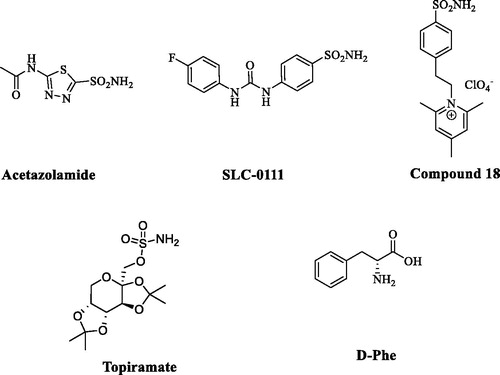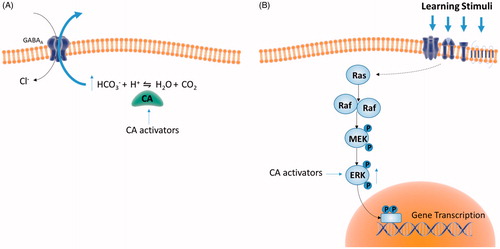Figures & data
Figure 1. CA inhibition (A–D) and activation (E) mechanisms. The zinc binders incorporate a ZBG (A); the compounds anchoring to the nucleophile an AG that interacts with the zinc-coordinated water (B). The inhibitors occluding the active site entrance (C) also contain AG moieties but bind more externally, whereas the inhibitor binding outside the active site are shown in (D). The activators bind in the middle of the active site and contain a proton shuttle moiety (PSM) of the amine, imidazole or carboxylate type (E). All these modulators incorporate various scaffolds and tails in their molecule.

Figure 2. Chemical structures of some CAIs/CAAs. The pan-inhibitor acetazolamide (non-selective inhibitor of all CA isoforms known in humansCitation35), the CA IX/XII-selective inhibitor SLC-0111Citation49 discovered by our group, in clinical trials as an antitumor agent, the membrane-impermeant positively-charged sulphonamide “Compound 18” (used as negative control in ref Citation27), topiramate, a clinically used antiepileptic agentCitation48 together with the non-isoform selective CA activator D-Phe.

Figure 3. Putative mechanisms underpinning CAs actions on cognition. (A) CA activation transforms GABA-mediated inhibition (Cl− conductance) into excitation due to increased HCO3– flux through the GABAA receptor channel. Such synaptic transformation allows GABA-releasing interneurons to act as either excitation filters or amplifiers of the neuronal networkCitation72. (B) CA activators increase ERK phosphorylationCitation27 which in turn regulates the activity of nuclear transcription factors promoting gene transcription, an essential step for consolidation of different learning stimuliCitation73–75. The CA isoforms as well as the cellular mechanisms related to CA-induced modulation of ERK activity were not identified yet.

